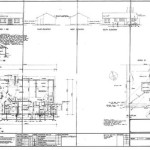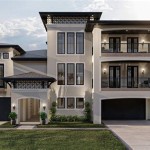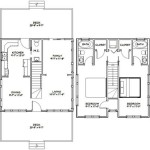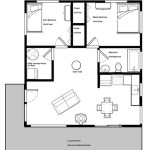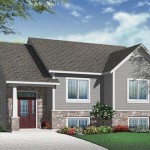Home Plans With Keeping Rooms: A Blend of Tradition and Modern Living
The concept of a keeping room, a cozy and informal space adjacent to the kitchen, dates back to early American homes. In past centuries, these rooms served as the heart of the household, providing warmth from the kitchen hearth and acting as a central gathering spot for family activities. Today, the keeping room is experiencing a resurgence in popularity, finding its place in modern home plans as a versatile extension of the kitchen, offering comfort and functionality for contemporary lifestyles.
The integration of a keeping room into a home plan represents a conscious effort to prioritize family interaction and create a more relaxed atmosphere. Unlike formal living rooms, which are often reserved for special occasions, the keeping room is designed for everyday use. It can serve as a place for casual dining, reading, watching television, or simply relaxing with loved ones. The proximity to the kitchen makes it convenient for parents to supervise children while preparing meals, or for family members to gather and converse while food is being cooked.
The design of a keeping room typically emphasizes comfort and warmth. Fireplaces are a common feature, providing both heat and a focal point for the space. Comfortable seating, such as sofas, armchairs, and ottomans, is essential for creating a welcoming environment. Natural light is also important, with large windows or skylights often incorporated to brighten the room. The décor is typically casual and inviting, reflecting the family's personal tastes and preferences.
Key Benefits of Incorporating a Keeping Room
The inclusion of a keeping room in a home plan offers several advantages, catering to both practical and emotional needs. Its inherent ability to foster family connection stands out as a primary benefit.
A significant benefit is the creation of a dedicated family space. In contemporary homes, formal living rooms are sometimes underutilized, reserved for infrequent gatherings. A keeping room, however, serves as a central hub for daily life, encouraging family members to spend time together. This shared space promotes communication, strengthens bonds, and creates lasting memories. Its proximity to the kitchen naturally draws family members together during meal preparation and other activities, fostering a sense of togetherness.
Another advantage is the enhanced functionality of the kitchen area. The keeping room extends the living space of the kitchen, providing additional seating and work surfaces. This can be particularly beneficial for families who enjoy cooking together or entertaining guests. The extra space also allows for more flexible meal preparation and serving arrangements. For example, the keeping room can be used as a buffet area for casual meals or a serving space for larger gatherings. The open floor plan between the kitchen and keeping room promotes a seamless flow of activity, making it easier to manage multiple tasks.
Finally, a keeping room adds value and aesthetic appeal to the home. It’s a desirable feature for many homebuyers, signaling a focus on family living and comfort. A well-designed keeping room can significantly enhance the overall appeal of the home, creating a warm and inviting atmosphere. The ability to customize the space to suit individual needs and preferences further increases its value. A keeping room can be adapted to serve as a playroom, home office, or hobby room, depending on the family's lifestyle. This versatility makes it a valuable asset that can be enjoyed for many years to come.
Design Considerations for Keeping Rooms
Designing a successful keeping room requires careful consideration of several factors, including size, layout, and style. The room should be integrated seamlessly into the overall home plan, complementing the existing architecture and décor.
The size of the keeping room should be proportionate to the size of the kitchen and the overall dimensions of the house. A keeping room that is too small will feel cramped and uncomfortable, while one that is too large will feel disconnected from the rest of the home. A good rule of thumb is to allocate approximately half the square footage of the kitchen to the keeping room. This will provide ample space for seating, a fireplace, and other furniture, while still maintaining a sense of intimacy. It is crucial to consider the anticipated use of the room when determining its size. A keeping room that will primarily be used for casual dining will require more space than one that will be used primarily for reading or relaxing.
The layout of the keeping room should facilitate easy flow between the kitchen and other living areas. An open floor plan is typically preferred, allowing for seamless transitions and visual connection. The placement of furniture should be carefully considered to maximize comfort and functionality. The fireplace should be positioned as a focal point, with seating arranged to take advantage of its warmth and ambiance. Windows should be placed to provide ample natural light and views of the surrounding landscape. Additionally, consideration should be given to the placement of electrical outlets and lighting fixtures to ensure adequate illumination and convenient access to power.
The style of the keeping room should complement the overall aesthetic of the home. Traditional homes may incorporate rustic elements such as exposed beams, stone fireplaces, and cozy fabrics. Modern homes may feature sleek lines, minimalist furniture, and contemporary artwork. The key is to create a cohesive look that reflects the family's personal style and preferences. The use of color, texture, and pattern can play a significant role in creating a warm and inviting atmosphere. Neutral colors can be used as a backdrop for more vibrant accents, while textured fabrics and natural materials can add depth and interest to the space. The integration of personal touches, such as family photos, artwork, and collectibles, will further personalize the keeping room and make it a truly unique space.
Integrating Modern Technology Into the Keeping Room
While the keeping room concept is rooted in tradition, it can be seamlessly integrated with modern technology to enhance its functionality and convenience. The incorporation of technology should be subtle and unobtrusive, ensuring that it does not detract from the room's cozy and inviting atmosphere.
Entertainment systems can be integrated discreetly into the keeping room without compromising its aesthetic appeal. Flat-screen televisions can be mounted on the wall or concealed within custom cabinetry. Sound systems can be hidden behind panels or incorporated into the ceiling. The use of wireless technology allows for seamless streaming of music and video from various devices. A well-designed entertainment system can provide hours of enjoyment for the whole family without dominating the space. Furthermore, smart home technology can be used to control lighting, temperature, and security systems from a central hub, providing added convenience and efficiency.
Wireless charging stations can be incorporated into furniture to provide convenient access to power for mobile devices. This eliminates the need for unsightly cords and clutter, keeping the space neat and organized. Smart lighting systems can be programmed to adjust automatically based on the time of day or the user's preferences. This can help to create a more comfortable and energy-efficient environment. Wireless speakers can be strategically placed throughout the room to provide immersive sound without the need for bulky equipment. By carefully integrating technology into the keeping room, it can be transformed into a modern oasis that caters to the needs of today's families.
The integration of efficient appliances also contributes to the overall functionality of the keeping room. While the kitchen remains the primary food preparation area, the keeping room can benefit from the inclusion of a small refrigerator for beverages, a microwave oven for quick snacks, or a wine cooler for entertaining. These appliances can be integrated seamlessly into the cabinetry, maintaining the room's aesthetic appeal while providing added convenience. The emphasis should be on selecting appliances that are energy-efficient and quiet, ensuring that they do not disrupt the room's peaceful atmosphere.
In conclusion, the keeping room represents a valuable addition to any home plan, offering a blend of tradition and modern living. Its focus on family connection, enhanced kitchen functionality, and aesthetic appeal makes it a desirable feature for contemporary homeowners. By carefully considering the design elements and integrating modern technology, a keeping room can be transformed into a versatile space that enhances the quality of life for the entire family.

Floor Plan With Keeping Room Sun Mbr Wing Porch That Extends From Sitting To Kitchen Country Style House Plans

Keeping Room House Plans Floor

Keeping Room Craftsman Style House Plans Floor

Big Five Bedroom House Plans Blog Dreamhomesource Com

Stylish And Smart 2 Story House Plans With Basements Houseplans Blog Com

Plan 15820ge Spacious Family Home In 2024 House Plans Manor

Angled Keeping Room Home Plan 15798ge Architectural Designs House Plans

22 Build It Hearth Room Off Kitchen Ideas House Design

Open Floor Plans Build A Home With Smart Layout Blog Dreamhomesource Com

Breathtaking Two Story Grand Room 12008jl Architectural Designs House Plans

